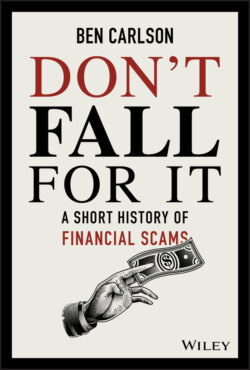Читать книгу Don't Fall For It - Carlson Ben, Ben Carlson - Страница 16
Selling the Eiffel Tower
ОглавлениеAfter a number of run-ins with the law, Lustig was looking to pull off one last big score to get out of the life of a con artist. Because the authorities in the US were onto his hijinks, Lustig went to Paris to pull off his pièce de résistance. Around the time Lustig returned to Paris, there were many stories in the local papers about the dilapidated state of the famous Eiffel Tower. A lightbulb went off in Lustig’s head. He set about creating a fake government role for himself, complete with his own stationary and business cards done up with an official French seal. There was even an official-sounding, yet completely made-up title: “Deputy Director General of the Ministry of Posts and Telegraphs.” Again using one of the finest hotels in the city, he set up shop at the Hôtel de Crillon, a stone palace on the Place de la Concorde. The biggest scrap metal dealers in town were summoned to the luxurious hotel for a secret business proposal.
“Because of engineering faults, costly repairs, and political problems I cannot discuss, the tearing down of the Eiffel Tower has become mandatory,” he reportedly told this group in a quiet hotel room. The Count then shocked the small group of metal dealers by announcing the Eiffel Tower would be sold to the highest bidder. Many at the table were in disbelief but Lustig assured them if the government was able to turn a profit on the deal, it would minimize the protests from citizens.[6] The 1,000-foot tall structure contains more than 7,000 metric tons of iron, along with 2.5 million rivets that held it together, so these scrap metal dealers could calculate the sale of this amount of metal would net a fortune to those who tore it down and sold off the parts. To make the process more believable, the dealers were even taken on a tour of the monument to give them a better sense of the scale of the operation.
Bids were due by the next morning along with the promise of complete secrecy from those involved. Lustig told his marks the government didn’t want word to get out for fear of a public outcry against tearing it down. Although he took bids from all interested parties, the patsy was picked out well in advance. Andre Poisson was relatively new to the area and trying to make a name for himself. What better way to make a name for yourself than by winning the biggest scrap metal project in the country’s history? A few days later Lustig informed Poisson his offer of 250,000 francs (roughly $1 million today) was in fact the winning bid. Once he learned he won, Poisson finally became wary of the whole operation. So to seal the deal, Lustig demanded a bribe for securing the transaction. Everyone assumed all Parisian government officials were corrupt, so the bribe was the final nail in the coffin to make it seem legit. Poisson was in.[7]
Lustig secured the cash and handed over the “official” paperwork to finalize the sale. After a number of failed attempts to claim possession of the Eiffel Tower, Poisson finally realized he’d been swindled. By this point, Lustig had already fled the country. But a funny thing happened as he waited to see a news story about the man who tried to sell the Eiffel Tower – the story never came. Lustig was initially befuddled, but eventually realized Poisson was so embarrassed he was taken advantage of that he never bothered telling the authorities to save face. Never one to rest on his laurels, Lustig decided to test his good fortune by going back to Paris to try selling the Eiffel Tower a second time! This time he wasn’t quite so lucky. The potential buyer went to the police before handing over the money, and Lustig was forced to flee the country yet again.[8]
Back in the States, the Count perfected his counterfeiting skills to the tune of more than $2.3 million over a five-year period. When the police finally apprehended him, Lustig had one more trick up his sleeve. As he awaited sentencing he pulled a jailbreak fit for a scene right out of a movie. Using a pair of stolen wire cutters (no one knows how he came to possess them) to open up his third-story window, he tied nine bedsheets together and used them as a rope to climb down three stories. The only problem was there was a crowd of roughly 100 people on Eleventh Avenue in New York City who saw him climbing down. Once he realized people were onto him, he took a rag from his pocket and pretended to clean the windows on his way down to pass himself off as a window cleaner. When he planted his feet on the ground, he gave the crowd a bow and ran away.[9]
Once the authorities finally caught up with the notorious con man, they took no chances, sending their new prisoner off to Alcatraz for a 20-year sentence. His death certificate listed his name as Robert V. Miller, but to this day no one knows his true identity or where he really came from. It wasn’t until 1906 that Parisian officials extended the Eiffel Tower’s contract to 1915, and a number of years later that they finally made it a permanent piece of the city’s magnificent landscape.[10]
